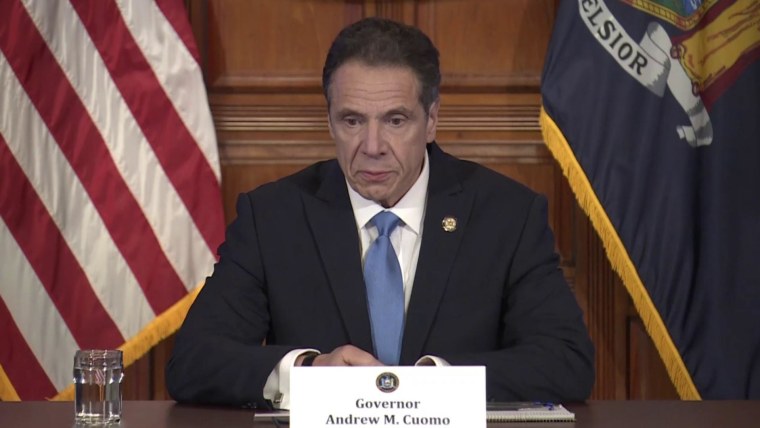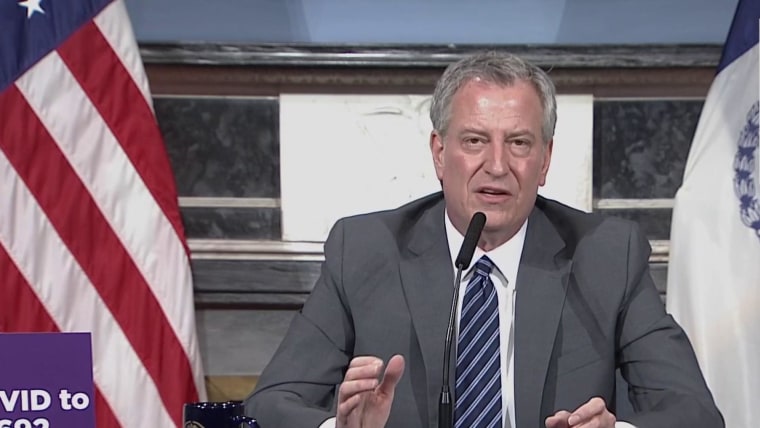Elizabeth Bonilla, a paramedic working in New York City, responded to a recent call for a cardiac arrest being suffered by a suspected coronavirus patient in her 70s.
“Practically every call you hear on the radio is a cardiac arrest,” Bonilla told NBC News.
The paramedic, who works in the Bronx, said she performed CPR on the woman as her family watched on in shock at how quickly she had taken a turn for the worse.
Last week, the governing body for New York City Emergency Medical Services issued an order that units could no longer transport cardiac arrest patients to hospitals unless there were signs of life at the scene.
Despite working furiously to revive the woman, eventually, there was nothing more they could do.
“We had to pronounce the patient on the floor,” Bonilla said. “That hurts, because you’re leaving them right there in front of their family.”
As Bonilla and her partner talked to the family and prepared to leave, the woman’s home health aide, who had been crying in the living room, went to the patient and gingerly cleaned her face one last time. The gesture moved Bonilla deeply.
“Every cardiac arrest I go to, I leave very emotional. I cry, because it’s real. It’s serious,” said Bonilla, who has worked as a paramedic for seven years. “People are outside walking around, and they don’t see the inside of what we see.”
The Fire Department of New York, or FDNY, has registered a staggering increase in calls for cardiac arrest patients as the city saw its count climb to nearly 78,000 known cases as of Wednesday morning, with more than 3,600 deaths.
Since the coronavirus came to the city, the FDNY has reported a 50 percent daily increase in calls for emergency services. But the number of cardiac arrest calls has been especially grim.
From March 20 through April 5, the agency logged an average of 195 cardiac arrest calls daily, with 129 people dying each day, according to statistics provided to NBC News.
Let our news meet your inbox. The news and stories that matters, delivered weekday mornings.
During the same time period last year, the FDNY averaged 65 cardiac arrest calls a day, and 27 of those calls, on average, ended in death, the statistics show.
“Now, in this pandemic, we are seeing more than 300 cardiac arrest calls each day, with well over 200 people dying each day,” the FDNY’s press office said.
Even more alarming, cardiac arrest patients during this period, which is the most recent for which data are available from the FDNY, wound up dying at an alarming rate of 66 percent, up from about 41 percent in the same period last year.
And the death rate appears to be accelerating. More than half of the 2,192 cardiac arrest deaths resulting from calls during the 17-day period occurred in the first five days of April, according to FDNY statistics.
“The dramatic increase of cardiac arrest calls and deaths from cardiac arrest calls demonstrates the impact suspected or confirmed COVID-19 patients are having on 911 and what EMS members are having to respond to every day,” a senior FDNY official told NBC News.
Paramedics and EMTs said they were hearing back-to-back cardiac arrest calls, many of which were suspected or confirmed COVID-19 patients.
“I’ve been to more cardiac arrests than in my whole career,” Bonilla said. “One minute the person is fine, and then the next minute the person just collapses.”
An EMT who also works in the Bronx said call volumes were extremely high and were a mix of cardiac arrest calls, people with the virus in respiratory distress and people with minor symptoms who were terrified and wanted to go to the hospital. There were also people with unrelated conditions who were afraid to be transported to the hospital for fear of contracting the virus there.
“Everybody’s scared,” said the EMT, who spoke on condition of anonymity.
Michael Greco, vice president of FDNY Local 2507, the union representing EMTs and paramedics, said the virus has completely upended the way they work.
“It’s just this perfect storm of pandemic that’s making normal operating procedure out the window,” he said.
Greco said EMTs and paramedics would need psychological resources to deal with the ongoing toll of responding to patients with the virus. Whereas before they might see a mix of more serious calls and some minor calls, coronavirus cases are overwhelming EMS teams.
“Not only is it just a constant for our members, it’s death, it’s destruction,” he said. “That break is no longer there, so it’s putting a strain that nobody’s been trained for.”
Greco said that in a normal cardiac arrest call, a patient would be seen by about 10 people, including an EMT crew and a paramedic crew.
After 20 minutes without signs of life, they could still set up transport to a hospital to see whether the patient responded to further treatment or call a doctor who could issue new orders or medications to give to the patient.
But in the midst of the coronavirus pandemic, there is a good chance that only two or at maximum four people will respond to a cardiac arrest call.
“This is the battlefield, wartime triage that we’re under,” Greco said.
Bonilla described responding to her first confirmed coronavirus call, a man in his 40s who needed oxygen badly.
“That was one of the most devastating jobs that I’ve done,” she said.
“It was almost like looking at the monster face to face,” she said. “The way he was gasping for air. The way he was sweating and how hot his skin was. His whole body was shaking.”
The crew treated the man and transported him to a hospital.
“I thought that he was going to be OK because he was young, but to find out he died the next day, it broke my heart,” she said.













